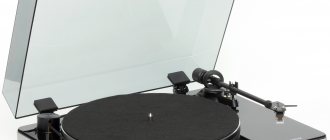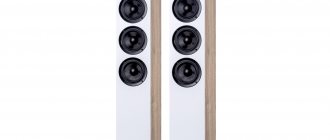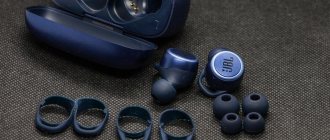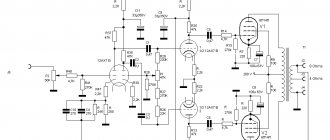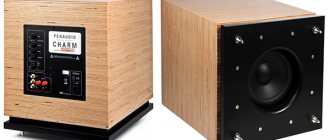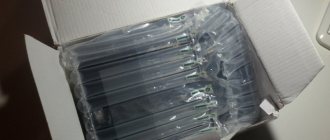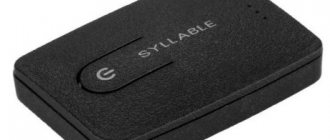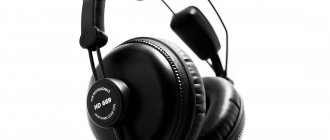Guys, excuse me, today I’m going to hit the spot (even though I tried to restrain myself and moderate my emotional outbursts as strictly as possible), because I have for you the best EISA active bookshelf speakers of the past season.
Save and read later -
This is the brainchild of the old and very respected German brand ELAC. I don't think anyone doubts that these are some of the most famous audiophile manufacturers on this planet.
Well, the ELAC Navis ARB-51 are medium-sized active bookshelf speakers. Not small, but not very big either. But immediately - what is called craftsmanship - superbly made cases: the skill with which it is all drawn, the curves, the combination of all these surfaces, the textures - all this is simply impeccable.
The German style is here, of course, in all its glory - nothing flashy, everything is extremely calm, restrained, but it looks and feels like... a Mercedes. A good, compact and inexpensive Mercedes.
The same cannot be said about the price - today these bookshelf speakers are valued at 125 thousand rubles, which is very reasonable for such sophisticated speakers. So in many ways they are more profitable than Mercedes!
Technique
You can’t tell at first glance, but these are three-way speakers: at the bottom there is a 13-centimeter woofer with a traditional ELAC aluminum diffuser, operating in the range from 44 to 260 Hz and loaded onto a bass reflex located at the rear.
But above it, in a closed volume, a cunning coaxial driver is installed. Its 10cm diameter aluminum ring cone handles midrange frequencies up to 2200Hz, while at the center is a soft dome tweeter that operates up to 28,000Hz.
The case itself rests on a metal (it seems) foundation, in which the amplifiers are mounted and there are, as you understand, three of them, and the company calls this amplification circuit “pure analog”.
The Germans hid there a classic 40 W class AB amplifier for the tweeter, and two BASH (Bridged Amplifier Switching Hybrid) amplifiers. As far as I understand, this is a kind of hybrid between D-class and AB, which allows you to combine the energy efficiency of the first with the sound quality of the second.
In fact, this is not an Elak development, BASH were developed and patented by the Canadian company Indigo and, by the way, they are often used in subwoofers.
Enivey, in these speakers we have bandpass amplification, which means excellent control of each driver, plus a fairly sophisticated tuning system.
If you look at the back panel, it will be worse than any other stationary amplifier: three three-position switches for fine-tuning frequencies (low, middle and high), a low-cut switch (if you are using a subwoofer), a gain switch (i.e. gain) and a pair of input connectors: RCA and balanced XLR. Well, in the lower part, on the chassis with amplifiers, there is a power switch and a connector for connecting a network cable.
Triphonic vs biphonic, 2.1 vs. stereo, changing the approach to choosing acoustics!
The most nonlinear element in a standard sound reproduction system, whether it is used for listening to music, as a home theater, or intended for both purposes, is the acoustics.
This is no secret to anyone, which is why most experienced people choose electronic equipment after making a decision about the speaker system. The choice is usually made by ear: well, who buys speakers based on characteristics, “should you check or go?” Experienced people, before listening, study the information available on the product, usually available on the manufacturer’s website, or from glossy magazines, as well as obtained on the Internet or from advice from more experienced users in forums. In the press, such information is presented in a light favorable to the manufacturer, but in magazines there is often only the subjective opinion of the journalist, which in most situations provides little useful information. Marketers use a well-known rule: most purchases are not a logical, but an emotional decision. Recently, company employees have begun to appear in forums, fortunately, access to them is anonymous. The advice of such people who actively promote their product is often difficult to distinguish from real advice from equipment users, and therefore the value of information from forums for the correct choice of product is significantly reduced.
How can we choose the right acoustics within the limits of our financial capabilities? What are the criteria for pre-selection before the stage of personal listening, which is not always possible, on the one hand, and very much depends on the effect of self-hypnosis and the acoustics of the room, on the other hand, which leads to selection errors. As a result, there is a lack of pleasure from the purchase and a constant desire to improve the system as financial opportunities improve. Instead of enjoying music and films, a person turns his desire to obtain satisfactory sound and image quality into a constant “arms race”, often not achieving the goal even at a very high price of equipment.
Acoustics, precisely because of their nonlinearity , is the main compromise in the system in terms of sound quality, the price of the elements used and the level of work of the designers. In addition, there is another important point of choice - conceptual. The concept of separate reproduction of LF and MF/HF, used for multi-channel signals, well covered in the works of Professor David Griesinger, Ph.D. Floyd E. Toole, Robert Stuart and in the materials of the AES (Audio Engineering Society), is gradually beginning to take a serious place in the world of High-tech End of sound. Just yesterday, a similar approach in acoustics was used only by M&K (especially famous in professional acoustics) and Atlantic Technology, as well as Snell and one or two European companies. Today, the number of companies producing sub+satellite sets is difficult to count. Many manufacturers, such as Genesis or Dali, for example, began to produce a symbiosis of active subwoofers with passive satellites. Heavy floor-standing passive monsters, which were fundamentally absent in professional recording studios, but widely represented in the High-End class, are being replaced by increasingly technically advanced subwoofers and satellites. The line of defense is still held by the legendary Wilson Watt Puppy 7, Legacy (both companies already produce subwoofers, however), but Klipsch has already released a sub with satellites, and the Kharma, which sounded great at CES2005, in terms of sound quality, is approaching yesterday’s unattainable leaders from the world of High-tech. End of passive full-range acoustics. However, there are monsters in the world of subwoofers - the “Master of the Universe” subwoofer B4 from SVS with an amplifier with a power of 1.5, 2.5 and up to 5 kilowatts, Servodrive B-DEEP 32 with a power of 1.6 kilowatts.
But we are interested in a completely different level - normal for ordinary people and standard rooms in terms of size, sound pressure level, and price level, of course. It’s even better this way - we’ll try to learn how to find the optimal solution for acoustics in terms of price/quality ratio, limiting the maximum to $1500-1800. If possible, we will use objective information in order, unlike most similar sources, to limit the subjective opinion of the author as much as possible and present an opinion based on objective data from other, authoritative and famous people in the world of audio.
This article is for those who think and look for solutions, usually finding them themselves.
It is impossible not to mention that the idea of using trifonics for high-quality sound reproduction was discredited by the mass production of multimedia systems that used high frequencies in the midrange to reduce their size, as well as subwoofers “only for cinema”, where a significant level of distortion did not allow achieving good sound quality for music. The opinion about triphonics “for computers” or “for cinema” is firmly rooted among many, becoming a stereotype for evaluating such systems. It's time to rethink the prevailing belief, especially since this is already happening everywhere.
Abbreviations used in the article:
- BM = bass management
- TA = control of phase delays (time alignment)
- EQ = equalization of device frequency response (equalization)
- HPF = High pass filter
- LPF = low pass filter
- HT = Home Theater
- PEQ = Parametric Equalizer
- AC = speaker system
- MIC = microphone
- DSP = digital signal processor
- LF - low frequencies
- MF - mid frequencies
- HF - high frequencies
- Frequency response - amplitude-frequency response
- PFC - phase-frequency response
- SPL - sound pressure level=SPL
- LI - linear distortion of the audio signal. They do not cause the appearance of additional harmonics, that is, sinusoidal signals that are multiples of the fundamental frequency. They are reversible, that is, they can be corrected, do not depend on the signal level and are caused by imperfections in the frequency response and phase response of the system.
- NI - nonlinear distortion of the audio signal. They depend on the signal level and cause the appearance of additional harmonics, they are practically irreversible, that is, compensating for such distortions is a very difficult task.
- SOI - nonlinear distortion factor (the ratio of the total RMS level of all harmonics in a given operating band to the amplitude of the fundamental frequency). To make it clearer, the averaged sum of all harmonic distortions in relation to the useful signal in the operating frequency band of the system is usually given in %.
- IR - system response to an impulse signal (impulse response).
- Satellite - a speaker that reproduces only mid and high frequencies, THX satellite - with 80 Hz
- Sub - subwoofer, a speaker designed only for bass (reproduction of low frequencies)
- SP - spectral package, a set of simultaneously reproduced frequencies of a musical instrument that determine the shape of its sound signal
- 1st order filter = 6 dB/octave frequency response rolloff
- 2nd order filter = 12 dB/octave frequency response rolloff
- 4th order filter = 24 dB/octave frequency response rolloff
Distortion in speakers
Let's try to analyze what we mean by nonlinearity in loudspeakers and how this nonlinearity affects the final sound quality.
This article does not pretend to be scientific, so the information will be simplified, understandable to people who have knowledge at the level of ordinary users.
As you know, nonlinear distortions are distortions of the signal shape that can be represented as the appearance of additional harmonics that are multiples of the frequency of the original signal. This is one of the main reasons for the deterioration of its playback quality. However, the difference in the hearing perception of nonlinear (or harmonic) distortions of different orders, as well as differences in hearing sensitivity at different frequencies, led to certain inconveniences in the level of assessing the quality of loudspeakers in terms of SOI level.
The difficulty is due to the fact that usually a significantly higher level of SOI in acoustics is perceived by ear differently than a significantly lower level of SOI in electronic devices due to the fact that in acoustics there are low-order harmonics that are less perceptible to the ear, and in electronic devices (except for tube ) the spectrum of harmonic distortion is usually quite wide, which is noticeable by human hearing at much lower levels.
Acoustic buyers are accustomed to comparing the SOI level by known levels of distortion in electronics, which forced acoustic manufacturers to abandon the use of this parameter in the specifications so as not to confuse users with very high HD levels, which in fact have not gone away.
Some acoustics sellers have found an excellent solution - they show the SOI level only up to a certain limit, for example, 5%. What happens above this limit is a secret, so as not to scare off buyers. Or the SOI measurement is given not over the entire operating range, but at specific, relatively high frequencies, where their level is usually significantly lower. Finding information about what the real SOI level is in certain speakers at different power levels throughout the entire low-frequency range is not at all easy - as noted above, this is not accidental.
The topic of nonlinear distortions in acoustics and their impact on sound quality has been discussed in several AES papers [1,2] [8,9], but we will not delve into this issue here. Let us note only one thing - reducing the SOI level in acoustics is no less important for the final sound quality of the system than in electronics , however, for the correct perception of these distortions by human hearing, it is necessary to take into account the order of the harmonics and the frequency of the main signal.
A type of nonlinear distortion also includes intermodulation distortion, when additional harmonics appear when two or more signals are played simultaneously, and these harmonics are the difference and the sum between the fundamental frequencies. The results of measuring such distortions are generally almost impossible to find in acoustics, and again not by chance.
These distortions also play an important role in evaluating the sound of the system, since they determine the clarity of the sound when playing music when a large number of musical instruments are playing simultaneously. Indeed, in the presence of a high level of intermodulation distortion, the main sound timbres of different instruments will be distorted by the added total or difference harmonics from the SP (spectral package) of these instruments, which is instantly noted by the ear as an unnatural, incorrect sound, “porridge” or poor localization due to masking of reflected signals [6] by harmonics, especially noticeable when playing hard rock or classical music in the presence of a large number of musical instruments. There are many other factors that influence the sound quality of acoustics, such as linear distortion due to uneven frequency response, phase distortion (when one frequency from the frequency band reaches the listener earlier or later than another, which also distorts the sound timbre and signal shape), pulse characteristic (reaction of the speaker to a short pulse signal, after the end of which the system returns to its original state for some time; the shorter this time, the less the speaker will add “of itself” - that is, in essence, distortion to the reproduced signal).
The sound quality is also affected by the level of maximum sound pressure at different frequencies, the radiation pattern of loudspeakers in different planes, group delay time (GDT) and other parameters. A detailed discussion of all these important indicators for the design of acoustics is beyond the scope of this article, however, we will return to some of them in a comparative analysis of the above-mentioned concepts.
Selection of systems for comparison and comparison of nonlinear distortions
Renowned scientist DBKeele, Jr., one of the most knowledgeable review authors for Audio magazine, always provides measurements of as many parameters as possible in his papers. Unfortunately, there are not so many such reviews, but we are lucky - we can take as a basis for comparison the Paradigm Studio 100 floor-standing speakers, measurement data for which was kindly provided by the above-mentioned author, who called them “a true flagship” - that is, “a true flagship” (last pages with testing).
It is also important that this review was published on the speaker manufacturer’s website, so its results are not in doubt even for him. These are reference floorstanding speakers that are fairly standard for our comparison and have been reviewed well by others. Their price is $1500-$1745, that is, just in the range we need.
For comparison, it would be nice to take a similar DBKeele review of the trifonic system. Unfortunately, the only similar review available to us is for the much more expensive M&K 5000THX system, which would be an unequal comparison. The lack of information on measurements does not allow us to compare other, more popular speakers in Russia, but the essence will not change - it’s worth taking a look at the SOI measurement graphs available on www.stereo.ru for different floor-standing speakers in the selected price range (and below) to understand , that even without information about the SOI above 5%, for almost everyone at a certain frequency of 30-40 Hz or slightly below the SOI “sharply goes off scale” beyond this 5%. Why?
Due to a sharp increase in the amplitude of oscillation of the woofer cone with a decrease in frequency and an increase in level, leading to forced mechanical limitation by stops or suspension (which is equivalent to a kind of clipping) and, accordingly, a sharp increase in SOI at this moment. Sometimes this is simply the nonlinearity of the speakers as radiating elements. However, in standard subwoofers (for example, Energy S10.2 at a frequency of 25 Hz at a sound pressure of 100 dB), the same thing usually happens, only at higher levels and lower frequencies. That is why such subwoofers are “non-musical” and are often used only for home theater, while other, “musical” subwoofers, which have a significantly lower SOI, often cannot provide a high sound pressure level precisely because of the need to have this low level of distortion.
Therefore, let’s take for comparison another system made up of the SVS PB10-ISD subwoofer, which is somewhat non-standard due to the specifics of the NI spectrum (we’ll see why later), known, like other SVS subwoofers, for a low overall SOI level at different sound pressure levels, including high. It is also useful, as an example, due to the numerous measurements presented by Ed Mullen, IrritateGuy (COF), Ilkka, as well as those carried out by the author of this article, to understand the essence and determine the reason for such a low comparative SOI for SVS subwoofers (and in their use in our trifonic system at low frequencies) at relatively high sound pressure levels. The price for such a subwoofer, according to svsub.ru, is $700, so we can include satellites priced at $1500-$1800 minus $700 = $800-$1100.
There are not many options, given the extreme limitations in the availability of data with the necessary measurements of the harmonic spectrum But since we are going to use these satellites with a VM, that is, with an HPF (a high-pass filter present in the receiver or AV processor when the satellites are set to “small”), the task is greatly simplified. It becomes quite enough for us to have fairly standard bookshelf speakers with good data on midrange and high frequencies, low SOI at these frequencies (we will also have to make do with general measurements without a spectrum) and it doesn’t really matter with what level of reproduction of low frequencies and SOI on low frequencies, since HPF will cut off these frequencies, and they will only be reproduced by the sub. Let's see how it looks in the picture, let's take the Mission M781 bookshelf speakers (price about $770) as an example; measurements can be viewed on the website www.stereo.ru - frequency response and SOI.
We see that taking into account the filter roll-off of 12 dB/octave, the total THD of satellites over the entire operating frequency range does not exceed 2% (in the case of using a 2nd order filter, and with a 4th order filter, usually used for non-THX modes, the situation will be better). For acoustics, this level of distortion is very good. Let's see what the subwoofer will produce at the same or slightly higher SPL (1-2 dB, if you prefer a little more bass, as recommended in the subwoofer calibration instructions), which will reproduce the region of low-frequency signals below 150 Hz For other speakers, the crossover frequency may differ, of course, M781 is just an example.
According to Ed Mullen's measurements, the PB10-ISD's THD does not exceed 2.7% at 22 Hz at 96 dB SPL at a distance of 2 meters from the subwoofer. Thus, your acoustic system (triphonic) will have a SOI of no more than 3% at sound pressure levels of 94-96 dB over the entire frequency range from 22 Hz to 20 kHz. Not all High-End floor standing speakers can boast such a low level of distortion at such a high sound pressure level, and few even twice as expensive subwoofers can show such a result.
My measurements confirm Ed Mullen's results (At 20 Hz the PB10-ISD has only 4% THD, actually made up of only the 2nd, less noticeable harmonic, at 106dB SPL - in a room this is typically 10dB higher than measured at open space, like Ed Mullen -96 dB):
At a frequency of 20 Hz, the almost top-end M&K MX-350 MkII subwoofer was able to produce 9 dB (slightly less than 3 times) lower sound pressure level when both the subwoofer and the measuring microphone were located in the same place, while its THD was twice as high . And yet, even with an M&K or similar subwoofer, the triphonic will sound with significantly less distortion than floor-standing speakers, for example, the Paradigm Studio 100 taken for comparison. Let's look at the picture with measurements from the DBKeele, Jr. review presented above. closer:
As you can see, already at a frequency of 41.2 Hz (and below the situation would be even worse), which is within the operating range of the speakers according to the specification, the level of SOI, and especially the 3rd harmonic, is very high (24%), and it decreases quite slowly with decreasing output level, reaching values comparable to our trifonic only at a power of about 10 watts, which indicates a high level of SOI already in the speakers themselves. The bottom right shows the output signal shape modeled based on these SOI levels at a maximum power of 100 watts. As we can see, it is far from the sinusoidal original signal, that is, it is noticeably distorted.
To the ear, such a sound is perceived as the muttering of speakers at low frequencies, which many often hear when using inexpensive floor-standing speakers - after all, the 41.2 Hz signal, as in our case, is mixed with the 3rd harmonic of a fairly high level, that is, a 120 Hz signal. It is frequencies of this order that are perceived as booming, harshness and smearing of the bass (this is easy to verify by adjusting the frequency response with a multi-band equalizer). If you remove the 3rd and 5th harmonics in this case, the bass will be soft and clear.
How to remove? Quite simply - by switching the floor-standing speakers to small, thereby filtering out high distortions in the low frequencies, and allowing a subwoofer with a low SOI level (for example, as discussed above) to reproduce the low-frequency components of the spectrum of the musical signal. And the floor-standing speakers will reproduce midrange and high-frequency frequencies in the same way as our M781 bookshelf speakers in the picture. Sounds a bit strange, doesn't it? How will these huge floor-standing units work as shelf-mounted monitors? It’s a pity to use them only partially. Do you want high-quality sound? Don’t be sorry, many smart people have already walked this path. For example, one of the luminaries of the American Audio-Video Science (AVS) forum, Professor Sushi from Texas, said the following:
“I have full-range floorstanders as front speakers (Hales System Two*) and still find it much better to use my Hsu VTF-3** subwoofer at a relatively high crossover frequency (in 2.1 or 5.1 matrix configuration), even for traditional 2- x channel music materials. After quite a bit of experimentation, I've decided that I prefer an 80Hz crossover frequency for both 2.1 and 5.1 configurations, with all 5 channels set to SMALL. There are many theories explaining why my preferences are not so unrealistic."
* High-End reference quality speakers for Robert Harley from Stereofile magazine - approx. by the author ** made in China, significantly worse than PB10-ISD in terms of maximum sound pressure, frequency response linearity and SOI level
Indeed, Professor Sushi’s preferences made it possible to figure out what the reason was and understand their logic. In good High-End floor-standing speakers, the SOI goes off scale at low frequencies at significantly lower frequencies than in bookshelf speakers, which allowed Sushi to use a lower crossover frequency of 80 Hz (see the bottom picture at the top of the article), and not as in our example 150 Hz, but the point is this has not changed - he also reduced the level of SOI in his system, as we did.
Intermodulation distortion, phase distortion and frequency response
What happens to the already mentioned intermodulation distortion when the reproduction of low frequencies and midrange/high frequencies is separated? By reducing the overall nonlinearity of the system across the entire frequency range, we also reduce the possibility of significant intermodulation distortion. Plus, by separating the paths and using active crossovers instead of passive ones, we also reduce the level of intermodulation distortion. These issues are well described by Rod Elliott in [4] and [5], we will not dwell on them.
Regarding phase distortion, consider the following illustration:
It shows the phase response of the Paradigm Studio 100 floorstanding speakers, which is quite standard and even quite good for the 3-way speaker system from the already mentioned review. Below is a quadripole phase response modeled at given points in Adobe Audition 1.5, and on the right are the original signal and the same signal after passing through the system with the shown phase response. A spectral packet was taken as a signal , consisting of a fundamental frequency of 50 Hz and four harmonics, decreasing in level by half in relation to the previous one.
As you can see, the final signal is significantly distorted in shape due to the phase response of the speakers. Such distortions cannot be noticed on a sinusoidal signal, but on a spectral packet (used as a first approximation as a model of a musical signal emitted by a real musical instrument), they are visible. The issue of audibility of phase distortions is described in [3], however, it must be taken into account that in our case, due to the noticeable difference (lower level) in the sensitivity of hearing to linear distortions compared to nonlinear ones [9], it is much less important than reducing the SOI by almost ten times .
The same signal was passed through a 4th order Linkwitz-Riley electronic crossover model with a crossover frequency of 80 Hz, the signals were separated by low-pass and high-pass filters, and then mixed, illustration:
The electronic crossover (in this case DSP), unlike speakers with passive filters, did not actually distort the signal; its final shape and frequency response (the red line as the final frequency response coincides with the yellow and green) exactly corresponds to the initial one. Thus, the final phase response of the system will depend on the phase response of the subwoofer itself (amplifier and speaker) and the phase response of the high-frequency and midrange parts of the acoustics. Consider the following image from the How Stuff Works page:
As you can see, in contrast to the passive filter and the rigid phase locking of the low-frequency speakers of floor-standing speakers to the midrange and high-frequency speakers, in the case of the triphonic there is an adjustment of the phase delay between the speakers and the subwoofer, which will allow you to achieve an almost ideal phase shift for any distance to the listener. When calibrating the system (which absolutely needs to be done, you can read in the instructions for the PB10-ISD how and why), the level between the speakers and the subwoofer is also consistent in terms of sound pressure and crossover cutoff frequency (see the picture in the title of the article, the zones circled in red ovals on bottom picture). Thus, in triphonics it is possible to achieve a more optimal coordination of the bass and mid/high frequency parts of the acoustic system in relation to the listener, which is especially important for multi-channel sound sources, since in them the low-frequency signal is transmitted over a separate channel (LFE) and simple mixing of these channels for playback through a stereo system with floor speakers without taking into account the influence of phase shift may be incorrect. For stereo signals, the separation of channels by a high-resolution electronic crossover (32-bit DSP), as we could verify on the model, does not introduce distortion, so the trifonic will also cope perfectly with playing back recordings on CD (as we could verify at CES2005 when listening to high-quality recordings Steve Hoffman on Kharma triphonic).
Using triphonic, we get not only a significant reduction in nonlinear distortion, a decrease in intermodulation distortion, better matching and a noticeable expansion of the frequency range into the low frequency region, but also an increase in sound pressure at these very low frequencies.
The advantages of trifonics are especially evident for digital signal sources, when all adjustments can be made in digital form before converting the signal to analog, thereby without losing quality. Only before being fed to analog PAs (in the case of digital ones, the need for such conversion disappears altogether) can such signals be converted into analog form.
This process occurs in modern AV processors and receivers when a signal is supplied digitally. The i-link and D-link digital interfaces are especially good for this for a number of reasons. Another serious factor for sound quality is the rapid development of the quality level of DSP, their resolution in processing low-frequency signals and computing power, often with double precision mode, which was done primarily for BM, already starting with the CS43926 series DSP processors.
An important advantage of using trifonic is a significant reduction in the load on the power supply of the receiver being used. Indeed, many budget devices have insufficiently powerful power supplies, or they are designed for a high-resistance load of at least 8 ohms. In the case of using floorstanding speakers with a resistance of 4 ohms, and even with 8 ohms, but a significant drop in impedance below the normalized 8 ohms in the operating frequency range, which is very common in floorstanding speakers, the load on the receiver's power supply exceeds the permissible limit and either overload protection is triggered, or wheezing is heard. Insufficiently filtered power ripples at signal peaks reach the speakers. This also happens when, for the sake of economy, electrolytic capacitors of relatively low capacity are used in power supplies of such receivers, for example, in the budget x11-x12 Pioneer line.
In such cases, using a subwoofer to reproduce the low frequency range is the optimal solution. Typically, a powerful power supply of such a device will take on the main load in the low bass up to the crossover frequency, and the receiver can easily cope with the reproduction of mid-bass and higher, firstly because the signal level at such frequencies is usually significantly lower than the lowest frequencies components. Secondly, because the user receives a higher level of total sound pressure due to the presence of a subwoofer and, operating the system at the same volume level, actually reduces the volume control level at the same SPL, thereby reducing the load on the PA and power supply receiver. Or, if you prefer, the system will sound louder and with less distortion at its maximum levels.
What about impulse response, how does a subwoofer speaker react to a rapid (pulse) change in the input signal? Good musical subwoofers are no worse than good floor-standing speakers, for example:
Room acoustic response
Below, as an example, is the acoustic response of a room with an area of 18.5 m² (kindly provided by the “Experienced Lamer”):
When this or a similar frequency response is superimposed on the frequency response of even the most linear loudspeaker or subwoofer, it takes on this form (the blue line shows the frequency response of the subwoofer):
And it doesn’t matter whether you listen to floor-standing speakers or triphonics, the result will be similar, precisely because of the reaction of the room. The topic of this article is not intended to cover the issues of standing waves, acoustic treatment of a room, or placement of acoustics. And yet, in the case of using our systems, how to deal with parasitic resonances of the room in order to obtain a linear frequency response? And here the trifonic system (subwoofer + satellites) has an undeniable advantage over floor-standing speakers for the following reasons:
1. To level out peaks at 25 Hz and 100 Hz, as well as dips at 70 Hz and 180 Hz, a 5-band parametric equalizer, for example Rane 17, can be used. Despite the difficulty of leveling frequency response dips (this can only be done in some relatively small limits) and ease of peak alignment, such a professional equalizer allows you to solve many issues related to LI. The use of a parametric equalizer is an expensive solution, but it is practically optimal and is recommended by many subwoofer manufacturers. Such PEQ will allow you to achieve almost linear frequency response for the listener's location. Turning on an equalizer between the low-voltage input of the subwoofer and the low-frequency output of the receiver or AV processor will not be difficult, and its operation will not affect the satellites and the sound range they reproduce, being responsible only for the parasitic resonances of the room and the low-frequency range. This will not work with passive floor-standing speakers - the equalizer must be turned on at the input of the preamplifier, and it will affect the entire operating frequency range of the loudspeaker.
2. To automate the EQ system, it is recommended to use receivers or AV processors that allow automatic calibration in the low frequency range, such as Harman Kardon 435, 635 or Denon 5805, 4806, as well as AV processors such as Lexicon MC-12 (with modification v4 ). Such receivers/processors are capable of optimizing room response within a listening position, or even across an entire room using multiple microphones. They are also designed to accept subwoofers for EQ acoustic response.
3. The use of subwoofers with built-in PEQ (such as the SVS Ultra series) or with built-in automatic calibration systems (such as the Velodyne DD series) will also solve the problem. As far as we know, this kind of floorstanding speakers using passive crossovers does not exist.
4. Moving the subwoofer in order to find the optimal place in the room to achieve the most linear frequency response in relation to the listener’s position, taking into account the resonances of the room, is much more convenient than full-range floor-standing speakers or bookshelf speakers. After all, for the latter it is also necessary to maintain the correct concept of the stereo base in relation to the listener.
Thus, the current trend of switching to systems with triphonics, clearly demonstrated at CES2005, is not accidental and, with the appearance of more high-quality musical (low-distortion) subwoofers on sale, will intensify. In specialized devices, which include a subwoofer, it is easier both technically and economically to implement the conditions required for high-quality bass reproduction. Naturally, a good subwoofer also has good parameters, just like good satellites . In general, do we need, in addition to low frequencies, infra low frequencies reproduced by subwoofers? Science answers - yes! [10].
Equipment
Sound path:
Pioneer 49TXi modified (AX10i) (as a processor for measurements, as a receiver for listening) Pioneer 47Ai (757Ai) (universal DVD/SACD player) Speakers M&K S-150 (front), M&K MX-350 MkII subwoofer, SVS PB10-ISD subwoofer Cables from the Lynx L22 kit, Monster Cable THX certified (interconnects), DynaMike 224S Pro (USA) - microphone connection and UB802.
Measuring path:
Behringer ECM 8000 - measurement microphone, calibrated by Kim Girardin TrueRTA v3.3.1 - real-time spectrum analyzer, pro version Level 4 RMAA - post-process spectrum analyzer (version 5.4 alpha with MLS support) Adobe Audition 1.5 - professional sound editor Lynx L22 — measuring sound card of the highest category, signal/noise 122 dBA Intel Pentium 4 2.2 GHz, 256 MB RDRAM The overall unevenness of the frequency response of the test system in the range of 20-200 Hz does not exceed 1 dB in this case.
Literature
1. A. Voishvillo (and others) - Graphing, Interpretation, and Comparison of Results of Loudspeaker Nonlinear Distortion Measurements, JAES, vol. 52 #4, April 2004. 2. Wolfgang Klippel - Measurement and Application of Equivalent Input Distortion, JAES, vol.52 #9 September 2004. 3. Arthur C Ludwig, Sr - Audibility of Phase Distortions 4. Rod Elliott - Benefits of Bi -Amping (not quite magic, but close) 5. Rod Elliott — Active vs Passive crossovers 6 . Jorn Otten — Factors influencing acoustical localization, dissertation 09.21.2001 7. Arthur C Ludwig, Sr — Audibility of Phase Distortions 8. Tue Haste Andersen and Kristoffer Jensen — Importance and representation of Phase in Sinusoidal model, JAES, vol 52. #11, November 2004. 9. Brian C. J. Moore and Chin-Tuan Tan - Measuring and Predicting the Perceived Quality of Music and Speech Subjected to Combined Linear and Nonlinear Distortions, JAES vol. 52 #12, December 2004. 10. Chen Gia Tsai - Perception of subharmonics - part of Ph.D dissertation, 11.28.2003
Sound
These are very, very detailed speakers. And this is the first thing that will catch your eye. We'll still have to look for such a sterile (in a good way) top. At first, such elaboration seems like a cold color, but when you listen to them for at least a couple of hours, you begin to understand that this is actually the same “high definition” reproduction, and not any color.
And these are very, very strong speakers. Probably one of the strongest booksellers I have ever visited. These German kids always hit it hard. I think I’m almost used to the fact that modern drivers with a small diameter can give way, but not that much. And here I sit again, looking at this 13 cm aluminum diffuser, and I am amazed at how much energy and attack it splashes out at me.
Really, different modern jazz things, like what Simon Ratcliffe from Basement Jaxx and the jazz duo Binker & Moses do (this project is called Village of the Sun), and this beauty sounds very strong from these ELACNavis, with such explosive energy that other floor-standing speakers will be jealous. And it's all in stunning detail, with superb separation of every tiny sound and absolute attention to detail. Very audiophile detailed and very three dimensional sound.
We also caught GoGo Penguin with their latest album. On good speakers you always hear things like string trembling, but here it is at some special height, just wow! German drivers are very attentive and meticulous with the soundtrack and will diligently show you every smallest overtone, so the realism here is frightening in places.
That is why on the ARB-51 it is interesting to listen to different “cunning” music, something at the intersection of genres, where different textures, unusual instruments and musical techniques can be combined, where there is some kind of musical storytelling, cinematography.
These Elakis are very rhythmic, keep the tempo perfectly and generally follow intonation in every possible way. I decided for myself that it was modern English jazz, jazztronics, something like Mammal Hands, AmbientJazz Ensemble that appealed to me and that’s all - a complete thrill.
As for rock music, I really liked how the latest Foals sound on these speakers - very atmospheric, with a lot of air and detail in the tops, the same clean mids and a very collected, lively lower register, so they drive you too will be able to hold it.
I noticed that one of the reviewers called these speakers warm in sound. But in my situation, I would not call these speakers exceptionally warm. I hear in them a good, pleasant warm bottom, but at the same time the middle and top are even, without any excess.
Trifonic
These speakers don’t need a subwoofer at all, but I had Elak’s branded sub, model SUB 2020, and I didn’t deny myself the pleasure. The flat body, more like a system unit, hides a carbon driver on the side wall, with a not very large stroke. Well, on the one hand, it somehow doesn’t give the impression of a bass machine, but it was, of course, interesting to try, and my premonitions did not deceive me - I have never seen anything like this in subwoofers.
He seems to be the smartest sub I've ever met. To begin with, it has its own application. Subwoofer app! It has no physical adjustments at all - on the rear panel there is only an RCA for connection, an indicator and a reset button.
But in the application you have a ton of different settings: mode presets, volume control, phase, delay, crossover frequency cutoff, and even a parametric equalizer.
But most of all I liked the automatic adjustment of the equalizer: you just leave the phone near it, the sub at this time “hoots” with its large carbon driver, and the phone uses a microphone to measure and record the curve in memory. The second time you do the same thing, holding the phone at the listening point. That's it, the sub is configured.
As for the quality of his work, I didn’t expect much from him - he looks too lifestyle. But, of course, the Germans are not fools, this corps is like that because... although more on that later. In general, everything was set up very competently, you couldn’t hear the subwoofer at all, it integrated flawlessly.
On my preamplifier I set the standard cutoff frequency to 80 Hz, on the speakers the same, and this whole triphonic turned out to be optimally tuned in just a couple of minutes. In the application, of course, I also played with presets: for example, there you can set it to music, cinema or night mode, but I liked the “smooth” Flat mode more, with it you get the optimal response, and, for example, in the Music mode everything -the sub is beginning to show itself slightly as a separate low-frequency machine, which seems wrong to me.
Does this system need a subwoofer? With it the sound becomes really more interesting, because first of all the stage becomes wider and deeper, the overall delicacy of the sound increases. But it costs almost 100 thousand, so it’s up to you to decide whether this increase in sound is worth the money.
In general, SUB 2022 is very good precisely because it is compact, you just don’t trip over it every time, and in this regard it is ideal - it does not catch the eye, does not take up much space, and it is really musical.
Without wires
The sub can also be wireless, just like this whole system! But to do this, you will need an optional adapter that will make the ARB-51 speakers themselves wireless. And now the sub can connect to this adapter and work from it. Of course I had an adapter too!
Everything is connected quite simply too - RCA from the pre to the adapter, the adapter to the socket, and on the speakers you need to set the input switches to the WR position, that's all. The system operates using the AirX wireless protocol at a frequency of 2.4 GHz. Thus, you get a completely wireless triphonic - after all, both the speakers and the subwoofer work wirelessly, and I don’t know who else can offer you such a comprehensive solution in this segment.
This is just a great option when you need to place the speakers further away or in some tricky way. In addition, ELAC has prepared another trump card - the subwoofer body is so flat for the reason that the manufacturer does not prohibit hiding it - even if you put it behind a sofa, or attach it to the ceiling - it even comes with mounts. And this, of course, will be a blow below the belt for your better half. No: “Get your terrible box out of here!”
It's a great thing, but you'll pay for disarming your wife - the transmitter can only transmit a signal with a resolution of 16/44, i.e. the high-res will begin to be downsampled, so that the perfectionist’s eye will begin to twitch.
As for me, I’m a suspicious son of a bitch, so my mind didn’t accept listening to high-records over this “wireless”: well, everything seems to be fine, detailed sound, panorama in place, dynamics the same, and even convenience, but...
But the nasty little audiophile in your head sits and pokes at the inside of your skull: “man, it can’t sound that good, look at those cool XLRs you have, only with them you can be calm.” In general, it’s pain and grief from the mind, because you hear on the wires their wildest resolution capabilities and simply cannot convince yourself that a wireless protocol with a 16/44 resolution can repeat this.
So guys, who needs these speakers. Firstly, they are perfectly equipped: six thoroughbred modern German drivers, six amplifiers with the ability to fine-tune and crossover adjustment, and what is very important for me is balanced switching. And all this is packaged in magnificent lacquer cases, costing only 125 thousand! Who can even suggest this?
Secondly, we can say that these speakers will play everything, because they do not paint anything at all, do not stick out or hide anything, but do only one thing - they try to follow the incoming phonogram as closely as possible. And, by the way, they can play very well at low volume, and this is a very important skill for me.
Therefore, if you value careful attention to the soundtrack, open-mindedness, versatility and good energy, then these ELAC Navis are simply a great option, especially for the price.
AUDIO set "Trifonic -80" is:
— two tube amplifiers m 14.4 and m 25.3 (one channel) manufactured in Tula;
— AC – open type;
— low-frequency box (subwoofer);
— a stand for equipment with 6 shelves.
Amplifier m 14.4 – single-ended class A tube amplifier using 6C33C tubes
(two lamps in parallel). Dual mono. The amplifier has regular and balanced inputs.
The m 25.3 amplifier is a push-pull tube amplifier using EL-34 lamps.
The amplifier has an input selector for 4 sources, a mixer and a filter are added
LF at 80 Hz.
Open type acoustic systems are available in two versions:
- on paper 8" broadband speakers like Visaton B200 - four speakers
in each speaker.
- on Kevlar 8" mid-bass speakers plus Fountek Neo-pro 5 ribbon tweeter.
This option uses a third-order passive filter at a frequency of 1.5 kHz.
Kevlar drivers are specially made for this type of acoustic design
and have a low diffuser mass.
Low-frequency box – bass reflex on dual Kevlar 10” heads.
Thanks to the use of two heads specially manufactured for a resistance of 16 Ohms,
managed to produce a small box. The heads are located one behind the other and
connected in parallel.
The project was created specifically for the m14.4 amplifier - a single-ended 6S33S.
Decent output power (50 W) made it possible to perform traditional closed
three-way, but I wanted tube speakers. The idea of using several broadband devices has long been toying with the ears. And what was needed was homemade
acoustics
What happened?
Four Visaton broadband speakers (B 200/6) produced very decent acoustics.
The speakers are connected in series/parallel. Total resistance 6 ohms.
I recommend these dins to everyone. But they are very expensive. We previously tried 4 pieces.
10GDSH-102 (10GD-36K) . Very loose low frequency spectrum. Mumbling at 160 Hz failed
eliminate even using speakers from different batches. The depth of the box is probably
influenced . There is nothing against theory. Twitter was also constantly requested on HF.
When the Visatons were installed, everything fell into place (German quality). They are not
I picked it up - there were only 8 pieces. I didn’t even measure the parameters, I screwed it on and here it is, a tube one
high quality sound.
I made an attempt to somewhat reduce the cost of the project. Which ultimately didn't work out.
I installed 8" mid-bass speakers. Sergey Zotov made on baskets from 10GDSh-1
Kevlar dynes for open design. In the group, the sound at low frequencies was pleasing, but
at frequencies above 1.5 kHz there are continuous bursts and resonances - apparently the structure of Kevlar. We needed a Twitter and not just a Twitter, but a powerful one, with a middle ground. Found in RuNet the tape-makers “Fountek” - a Chinese company with customers in Ukraine. I purchased the model
Neo-pro-5. Very interesting, non-inertial sound. To connect the dins, we had to install a second-order filter at 1.5 kHz. I tried it at 800 Hz from the beginning - tape
doesn't pull. We got the frequency response of Neo on CLIO. It clearly does not provide the declared 102 dB. Max – 95 dB. And the bandwidth is decent from 1.5 kHz. Small hump at 10 kHz. Kevlar
They fit together well, apparently a light diffuser. But there were no interesting low frequencies.
So you need a SAB.
According to the experience of sabotage construction (100GDN-45, 100GDN-3, 75GDN-1, etc.), the optimal option is obtained only when the volume of the box is no less than the equivalent volume.
For home use, a smaller volume would be needed. When using double
heads, the total equivalent volume is equal to the sum of the volumes of both speakers divided
by four. This interesting fact will help us defeat size.
The sub is made with a volume of 56 liters with a bass reflex pipe at a frequency of 32 Hz.
The speakers are converted to thin Kevlar 6GD-2 by Sergei Zotov.
The coils are wound at 16 ohms.
Here are the speaker parameters:
fs=31.5Hz, Vas=114l, Qt=0.42.
fs=30Hz, Vas=128l, Qt=0.37.
The speakers are installed at a distance of 100 mm one after another. The wall thickness of 100 mm was achieved due to the external lining and a small insert from the inside. Bass reflex pipe
rectangular section. By connecting the dins in parallel, the result was a SAB with very decent pressure and a resistance of 8 Ohms (under a lamp)
Amplifier for SAB. One channel from Tula m25.3 - RR on EL-34 was used.
In place of the other one, two cathode followers, a mixer and
3rd order low pass filter at 80 Hz. The tunable filter turned out to be ineffective.
The regulator was always set to the lowest cutoff frequency, so the filter was applied without a regulator. The amplifier has a master volume control that allows you to control the volume of the entire set.
Conclusions.
It is advisable to supplement speakers on broadband speakers with a low-frequency box (Sub).
In small-volume home subwoofers, dual heads should be used.
The acoustics on several full-range speakers work great with lamps and
sounds at the level of very expensive branded models.
Group activation of speakers of the same type (four or more) has a positive effect
on the linearity of the system
Ribbon tweeters also require lightweight mid-bass speakers.
Author: Vladimir Konstantiovich
You may be interested in:
|
Comments on articles on the site are temporarily disabled due to a huge amount of spam.

